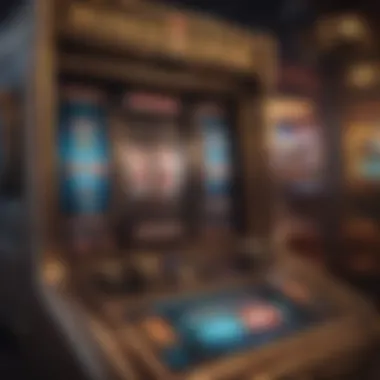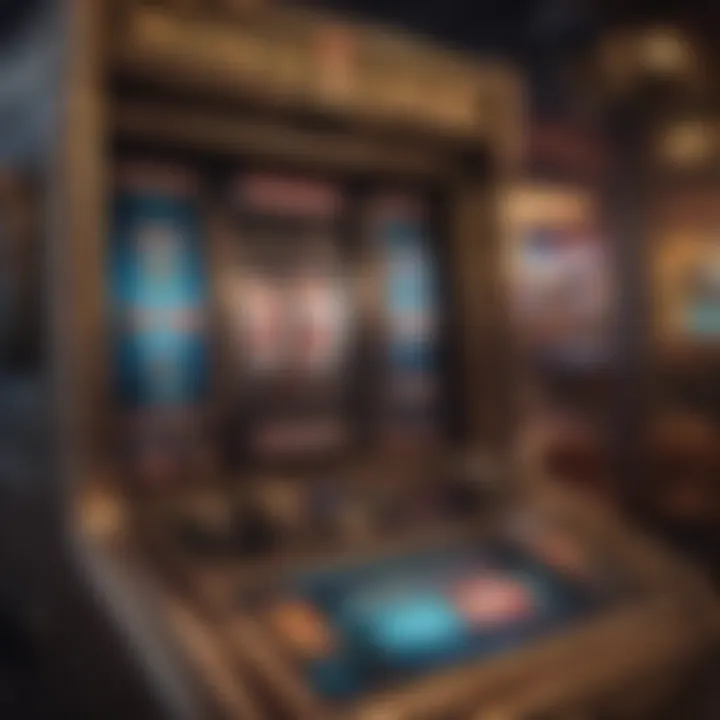Exploring the Future of VR Slots in Online Gambling


Intro
The landscapes of gambling and gaming have witnessed substantial evolution, particularly with the advent of digital technologies. Among these is the burgeoning field of virtual reality (VR), which is reshaping how players engage with games online. While traditional slots have been a staple in casinos for years, VR slots present an exciting new frontier that combines advanced technology with thrilling gameplay. This intersection of virtual reality and gambling offers immersive experiences that stand to engage users in ways previously thought impossible.
As we delve into the realm of VR slots, it's key to understand not just how they work, but also what makes them distinct from their traditional counterparts. From interactive environments to lifelike graphics, the user experience is transformed. What draws players in more effectively? How do the technological underpinnings support this shift? Exploring these questions will illuminate the many angles from which VR slots are revolutionizing online gambling.
The future of this industry is at a crossroads with countless opportunities and challenges emerging for both providers and players. This exploration not only highlights these aspects but also aims to inform readers about what they might expect as we delve deeper into this fascinating fusion of technology and gaming.
Prolusion to VR Slots
The trend of virtual reality in online gambling is more than just a flash in the pan; it is reshaping the very essence of how players engage with slots. VR slots present a fusion of cutting-edge technology and the age-old thrill of gambling, creating a playground where virtual and reality intermingle. Let’s take a closer look at what precisely makes VR slots a vital element in the evolution of the gaming industry.
Definition of VR Slots
Virtual Reality slots are essentially slot games that utilize VR technology to create immersive gaming experiences. Unlike typical online slots, where the player interacts through a computer or mobile device screen, VR slots transport users into a three-dimensional environment—bringing the casino floor right into the comfort of their living rooms.
More than just a gimmick, these machines tap into the visceral excitement associated with in-person gaming. Players can look around and immerse themselves in a completely new world designed to enhance the thrill of the game. This element of presence, where one feels physically there in a virtual space, is what distinguishes VR slots from the rest.
Historical Context of Online Slots
Early Development
When we peel back the layers on the history of online slots, we find the seeds of innovation planted back in the late 1990s, a time when digital technology was beginning to gain traction. The first online slots were little more than digital replicas of their land-based counterparts, featuring basic graphics and straightforward gameplay. The key characteristic of these early iterations was their simplicity. They were appealing, allowing players to engage straightaway without much fuss.
While it was a beneficial launchpad for online gambling, the early development of slots lacked the depth and complexity that players often crave. This was a time before animations and interactive features became standard, and the unique aspect of these early games was simply their novelty—giving players the chance to spin without needing to visit a casino. However, their limitations were clear; variety and excitement were in short supply.
Evolution of Technology
Fast forward a decade, technology began to evolve significantly. From the introduction of sophisticated graphics to the implementation of random number generators, the online gambling landscape began to flourish. The change was pivotal; slots gained intricate animations, storylines, and multi-layered gameplay. This evolution directly contributed to the online gambling community’s growth, drawing in both casual gamers and devoted fans alike.
What set this evolution apart was not just the graphics or sounds but the mechanics themselves, transforming how players experience gaming.
Overview of Virtual Reality Technology
Basic Concepts
Virtual Reality technology represents a stage of advancement where users can engage with computer-generated environments in a way that feels immediate and engaging. It isn't just about visuals—it's about creating experiences. The central concept lies in immersion. Players don special headsets, enabling them to view 360-degree environments, interact with objects, and engage in gameplay like never before.
This adds a layer of realism that traditional online slots simply cannot match; it's as if you’ve been whisked away to a different realm. However, the learning curve to get accustomed to VR can be intimidating for some.
Current Applications
At present, VR technology finds its way into various aspects of gaming, with VR slots being a notable highlight. With burgeoning popularity, many developers like Playtech and Microgaming are investing in this technology to bring forth engaging gaming experiences. These applications are not limited to just solitary play—many allow for multiplayer experiences, somewhat emulating a social atmosphere akin to physical casinos.
Yet, the ability to step inside a virtual casino, roam around, and engage with others adds a new layer of social interaction that players have yearned for during online sessions.
There's an immense potential that lies within this blending of two worlds, but it comes hand in hand with challenges and plenty of rooms for growth.
How VR Slots Function
Understanding how VR slots function is crucial as it sheds light on the mechanics and appeal that separate these digital games from traditional slot machines. With the integration of advanced technology and immersive experiences, VR slots are redefining online gambling. This section will explore the technology behind VR slots, the required hardware, and the user interface, aiming to give readers a well-rounded overview of these innovative games' operation.
Technology Behind VR Slots
Software Architecture
Software architecture plays a pivotal role in making VR slots a unique gambling experience. At its core, it consists of various components designed to work seamlessly together. One prominent characteristic of this architecture is its modularity. This allows developers to upgrade or modify specific parts without disrupting the entire system. Such adaptability can significantly enhance game longevity and user engagement.
A standout feature of VR software is its ability to create rich, dynamic environments where players can interact not just with the slot machines, but also with other players and the virtual world. While this can heighten the overall experience, it comes with challenges. For example, developing complex algorithms to manage interactions can be resource-intensive, affecting loading times.


Hardware Requirements
The hardware needed for VR slots is another fundamental aspect that contributes to the overall gaming experience. High-performance computers or gaming consoles are necessary to run the demanding VR applications smoothly. This characteristic is fundamental because low-end devices might struggle to deliver the high frame rates required for an immersive experience, leading to discomfort for players.
A compelling feature to consider is the sophisticated headsets that often accompany VR slots. Devices such as the Oculus Quest or HTC Vive provide not only visual fidelity but also motion tracking, enhancing user engagement. However, the need for such specific hardware can limit access, particularly for casual gamers who may not want to invest heavily in technology just for a game.
User Interface and Interaction
Game Mechanics
In the realm of VR slots, game mechanics are designed to provide a captivating user experience. Unlike traditional slots that often rely on static visuals, VR allows an interactive environment where players engage with the game flows actively. This characteristic is crucial because it enables a more engaging experience that may encourage players to spend more time on these platforms.
An intriguing feature is the use of gestures and voice commands, which are commonly incorporated into VR game mechanics. These allow players to spin reels or select bonuses using natural movements, bridging the gap between the physical and virtual worlds. However, this immersion requires a learning curve that not all players might appreciate, especially those who prefer simpler interactions.
Immersive Features
Immersive features in VR slots are designed to take player engagement to another level. Enhanced environments, 3D audio, and interactive elements create a sensory-rich experience that makes players feel they are in a real casino. This characteristic is essential, as it can significantly elevate the enjoyment and excitement associated with gambling.
One unique feature of these immersive aspects is the ability to participate in themed environments, allowing users to feel as if they're in a bustling Las Vegas casino or a serene beach slot setting. However, the downside might include a heavy reliance on hardware and software quality, as glitches can spoil the experience.
The interface and immersion of VR slots present a fascinating evolution in gaming, transforming routine play into an engaging adventure.
Players looking for social interaction might find these features appealing, but they could also deter those who prefer straightforward gaming experiences with minimal distractions.
In closing this section, it is clear that VR slots combine various technological elements that work holistically to create innovative online gambling experiences. By delving into software architecture, hardware requirements, game mechanics, and immersive features, we gain insight into how these slots function on a fundamental level, setting the stage for a new era in online gaming.
Appeal of VR Slots
The appeal of VR slots is multifaceted and lies at the intersection of technology, user experience, and social interaction. As the gambling industry ventures further into immersive technologies, understanding what draws players to these games is crucial. VR slots not only replicate the excitement of traditional casinos but also infuse new features that enhance engagement and interactivity. Given that gambling is as much about the experience as it is about the potential wins, VR slots stand as a significant breakthrough.
Enhanced User Experience
Visual Elements
In the world of VR slots, visual elements play an indispensable role in attracting players. The use of advanced graphics and 3D animations creates a breathtaking environment that imitates a physical casino. What sets VR visual elements apart is the immersive experience they provide, allowing players to feel as if they are genuinely inside the game. Unlike standard online slots where visuals can sometimes feel flat, VR brings the game to life with vibrant colors, detailed symbols, and fluid animations.
One unique feature of these visual elements is the ability to customize the gaming environment. Players might find themselves in various thematic settings, whether it's a lavish Las Vegas-style casino or a fantastical world filled with mythical creatures. This variety not only keeps things fresh but can contribute to a greater emotional connection to the game, which is essential for maintaining player interest.
However, the flip side is the technological demands—realistic graphics require high processing power, potentially limiting access to players without robust systems. This could lead to exclusions based on hardware capabilities, which is a noteworthy disadvantage when considering the broader audience.
Sound Design
Equally crucial to the user experience in VR slots is sound design. It envelops players in an auditory landscape that complements the visuals beautifully. The sounds of coins clinking, whimsical music, and the cheers of virtual fellow players work together to create a dynamic atmosphere that a traditional slot machine can't replicate.
By using binaural audio technology, VR slots can provide directional sound, meaning players can feel as if they are surrounded by the action. This characteristic of immersive sound elevates the experience, as players feel more present in the game.
One unique feature of sound design in VR slots is the ability to tailor sounds to suit the individual preferences of players. For instance, a player might enjoy one genre of music that enhances their overall enjoyment while playing. This personalization is a strong advantage as it allows gamers to create their ideal auditory environment, increasing their chances of returning to the game.
On the other hand, not all players may appreciate the sounds, as overdone audio effects could be a distraction, pulling them out from the immersive experience intentionally created.
Social Interaction
Multiplayer Options
Multiplayer options in VR slots represent a significant evolution in how players engage with each other. Unlike traditional slots where social interaction may be limited or non-existent, VR slots allow players to join forces with others in real-time. This characteristic contributes to a more community-centric gaming experience, where players can chat, celebrate wins, or share tactics in a way that mimics real-life interactions.
The unique feature here is the ability to see avatars of other players in real time. This adds a layer of camaraderie and competitive spirit that traditional online slots can’t match. It creates a social milieu where players feel part of a larger community, making the gaming experience more enjoyable.
However, multiplayer options can sometimes complicate games, leading to lag or delays, which could frustrate players looking for a smoother experience. Balancing these aspects will be crucial for future developments in VR slots.
Community Engagement


Community engagement in the realm of VR slots takes on new dimensions. Developers are recognizing that players want to connect beyond just winning and losing. Many VR slot platforms now include social features such as forums, leaderboards, and challenges that foster ongoing interaction among players.
At its core, the idea behind community engagement is simple: create a space where players can share experiences, tactics, and stories. This engagement rounds out the gambling experience, creating bonds over shared interests, such as favorite games or strategies, making players more likely to stick with a platform.
A unique feature of this community engagement is the ability to host virtual events and tournaments. Players can compete against one another, adding an extra thrill to the experience. While this social atmosphere can be captivating, it may also turn off those who prefer solitary play or find the competitive environment stressful.
"In an age where interaction can hinge entirely on screens, VR slots offer a bridge back to community and engagement that many players have been craving."
In sum, the appeal of VR slots lies not only in their innovative design and features but in their ability to create a compelling user experience where players can interact, share, and enjoy their time in a virtual environment that feels almost tangible.
Comparative Analysis with Traditional Slots
The landscape of online gambling has always been about adaptation and innovation. Comparative analysis with traditional slots dives into this transformation, especially as virtual reality slots stake their claim in the gambling world. Analyzing how VR slots stack up against traditional counterparts isn’t just an academic exercise; it reveals fundamental shifts in player engagement, technology, and the overall gambling experience.
Understanding gameplay differences, player demographics, and the overall appeal offered by VR slots sheds light on why they are becoming a favored choice for many.
Gameplay Differences
Rounds and Paylines
When it comes to rounds and paylines, one of the notable distinctions between traditional and VR slots lies in the mechanics. Traditional slots typically operate on a fixed number of paylines with predetermined outcomes, creating a straightforward yet somewhat predictable experience. Conversely, VR slots often embrace a more dynamic Interaction with multiple paylines that adapt based on player decisions. This feature adds layers of excitement and strategy to the game, merging traditional probabilities with modern gaming experiences.
The flexibility in maneuvering paylines can amplify a player’s decision-making process. Imagine a situation where you pull the lever, and based on an interactive game element, you may choose to adjust your paylines for that round. This not only caters to seasoned players seeking depth but also invites casual players into the mix with its intuitive design. Yet, the complexity can be a double-edged sword; some new players might feel overwhelmed by this extra layer of choice.
Bonus Features
Bonus features are another cornerstone that sets these two worlds apart. Traditional slots often include bonus rounds that can deliver a hefty payout, but their mechanics usually remain static across games. VR slots, however, innovate this element drastically. They can offer immersive bonus rounds where players might find themselves transported to a new environment, facing unique challenges tailored to the theme of the slot.
A unique feature of these VR bonuses could involve players needing to engage with physical elements in their environment to achieve the bonus, thus reinforcing those immersive qualities. While traditional bonus rounds can indeed be exciting, the extra layer of immersive experience in VR can keep players engaged longer, provided the experience is designed well. The downside is the development cost; creating these features demands time and resources that may not pay off for every title.
Player Demographics
Attraction to Casual Gamblers
The attraction to casual gamblers tends to hinge on accessibility and user experience. For casual players, traditional slots often provide a comfort zone due to their simplicity. However, intersection with VR can stir curiosity. VR slots introduce casual gamblers to a novel environment where the stakes seem higher, and the experience feels richer. Getting booted into a vibrant, animated world while spinning reels certainly piques interest, drawing in those who might have otherwise stayed away from the gambling scene.
These gamers may appreciate the minimalist controls and intuitive interfaces that don’t require extensive gaming knowledge. They might be intrigued by the opportunity to enjoy unique rewards or experiences that traditional slots simply can’t offer. But this excitement can be fleeting; without proper engagement strategies, casual players might quickly lose interest if the games lack depth post their initial attraction.
Engagement by Experienced Players
For experienced players, the depth and complexity that VR slots promise can be nothing short of enticing. These seasoned gamblers often seek intricate gameplay that pushes their skills to the limit. They relish the interaction and strategic potential VR slots deliver, allowing them to exercise their expertise in a more compelling environment.
A feature sought after by experienced players may include tournament modes within VR slots, where they can test their strategies against others in real-time. This can create a competitive atmosphere that traditional slots simply lack, enhancing their overall gaming experience.
However, it’s essential to note that even experienced players can find VR slots daunting if the technology doesn't mesh well with gameplay. A poorly executed VR experience might leave them frustrated rather than engaged, thus necessitating a careful balance in design and execution.
Challenges Facing VR Slots
In the world of virtual reality slots, the glitz and glamor can sometimes overshadow the hurdles that developers and players must face. Understanding these challenges is crucial for grasping the future landscape of VR gambling. The importance of addressing obstacles such as technical issues and regulatory barriers cannot be understated. Without a good grasp on these elements, the potential growth and popularity of VR slots could stall significantly.
Technical Obstacles
Network Latency
One can't overlook the impact of network latency on the VR gaming experience. In simple terms, network latency refers to the time it takes for data to travel between your device and the VR server. A high latency can dampen the immersive feel that VR promises. If a player pulls the lever on a slot machine and the response is delayed, it snatches away the excitement from the experience. The key characteristic here is responsiveness. A smoother interaction not just enriches gameplay; it builds trust in the system. The unique feature of optimizing data transmission can lead to faster response times, but achieving this can be tough in crowded networks, especially during peak hours.
Hardware Accessibility
On top of that, hardware accessibility plays a pivotal role in how many people can enjoy VR slots. For many, VR headsets like the Meta Quest or the HTC Vive are still not budget-friendly. This limits who can get involved, especially casual gamers or those who are just starting to explore online gambling. The crucial aspect of affordability and availability of suitable devices can either lead to a boom in player numbers or keep them at bay. Consequently, while the advantage of having advanced technology can lead to stunning visuals, the disadvantage lies in its high cost, creating a barrier for wider adoption.
Regulatory and Safety Issues


Licensing Requirements
As with any gambling venture, licensing requirements are of utmost importance in the world of VR slots. These requirements ensure that the gaming platforms follow set standards and contribute to a fair gaming environment. Regulatory bodies are always on the lookout for compliance. The advantage of having these rules is that it promotes trust among users — knowing they engage in a safe and transparent environment. However, the drawback is the sometimes lengthy and convoluted process of acquiring licenses, which can hinder new developers from entering the market.
Privacy Concerns
Finally, we can't discuss challenges without addressing privacy concerns. As users immerse themselves in virtual worlds, their data is more exposed than ever. Users often provide personal information when they sign up, and any potential data breaches would be a cause for alarm. The key characteristic of robust data protection measures is essential, and many players prioritize safety over fun. On the plus side, stronger privacy policies can build a solid foundation for user loyalty. On the flip side, navigating the complexities of privacy laws across different jurisdictions can be burdensome for VR gambling platforms.
Future Prospects of VR Slots
The landscape of online gambling is continually evolving, and VR slots represent a seismic shift in how players engage with games. As we peer into the future of this vibrant segment, it's essential to consider various elements that underscore its potential. The idea isn't just about having a good time on a virtual machine; it's a broader speculation about how immersive technology can transform gambling as we know it.
Industry Trends
Growth Forecasts
One of the most significant aspects of growth forecasts in the VR slots industry is the projected exponential adoption in the coming years. Various industry analysts agree that we are standing on the brink of a boom, with estimates suggesting that the global market for VR gaming is set to explode. Factors driving this expected growth include an increase in the general comfort with VR technology and its integration into mainstream entertainment.
The compelling characteristic of these forecasts lies in their forward-looking perspective. In contrast to more traditional forms of gambling, VR slots tap into the idea of enriching experiences. This resonates deeply with younger audiences who are accustomed to immersive gameplay in other domains. The potential for VR slots to become a staple in online casinos is fueled by their ability to offer heightened levels of engagement and interaction, making a night at the casino feel more like stepping into an entirely different world.
The unique feature that further sets aside VR growth forecasts is the immediacy with which they can adapt to technological advancements. One minute, you’re spinning virtual reels in a casino environment, and the next, you’re engaging with a community of players via avatars. The downside, though, is the need for constant upgrades in hardware and software, which can pinch the pockets of both developers and users in a rapidly changing tech landscape.
Emerging Technologies
Emerging technologies are critical in shaping the viability of VR slots, as they usher innovations that make gameplay not just more interesting but also more accessible. The advent of platforms such as Oculus Rift or HTC Vive has pioneered VR experiences that blend gaming with social elements.
The hallmark of these technologies lies in their interoperability. This means that developers can create games that not only stand alone but can also communicate with other platforms. As a result, players may find themselves switching between VR slots, traditional slots, and other multiplayer games seamlessly, enhancing the overall gaming experience.
However, the integration of these emerging technologies isn't without hurdles. The demand for better graphics, less latency, and more realistic haptic feedback can push costs related to equipment and game development higher. This may alienate casual players who are not yet ready to invest in high-end VR setups but want to participate in the thrilling world of slots.
Potential for Innovation
New Gameplay Concepts
The future of VR slots also hinges on the introduction of novel gameplay concepts that challenge conventional notions of how slot games operate. Imagine being able to manipulate the environment or interact with bonus rounds through physical movements or gestures. This creativity in gameplay design can transform how players view and play slots.
The key characteristic of these concepts is their engagement potential. By allowing players to influence outcomes actively or explore unique challenges within the plot, the experience can transcend traditional gaming. This approach not only caters to individual playstyles but also encourages community participation, as players might seek to share strategies on platforms like reddit.com.
Although these innovations come with their advantages, such as maximizing player involvement, they can also complicate game design. Developers face the question of how to balance complexity with user-friendliness, especially for new players who might feel overwhelmed by intricate mechanics.
Integration with Other Gaming Platforms
Another promising avenue lies in integrating VR slots with other gaming platforms. This is where online casinos could really leverage the popularity of multiplayer matches or role-playing games, introducing cross-platform functionalities that could keep players engaged across various environments.
The remarkable feature of this integration is that it fosters collaboration and competition among players. Integrated ecosystems allow users to earn rewards in one platform that can be utilized in another, enhancing user engagement and driving loyalty across different gaming experiences. This creates a sense of community, akin to what you'd find on platforms like facebook.com.
However, the integration challenge is monumental. Developers must ensure that the gaming experience feels cohesive, not jarring, as users transition between virtual worlds. Moreover, there are regulatory hurdles to navigate, which may slow down this innovative wave.
Culmination
The exploration of VR slots in this article underscores their burgeoning significance in the realm of online gambling. By integrating virtual reality into the gaming experience, we witness a profound shift that is setting new benchmarks for player engagement and entertainment. The immersive nature of VR slots not only captivates players but also adds a layer of excitement that traditional slot machines simply cannot match.
Summing Up the Exploration
To wrap up, it is clear that VR slots offer an innovative pathway for the gambling industry. This technology allows users to step into a 3D environment where they can spin the reels, hear authentic sound effects, and even interact with fellow players. Just imagine sitting in a virtual casino, with the ambiance of roulette wheels spinning and cards shuffling, all from the comfort of your home.
Despite being in its nascent stages, the excitement surrounding VR slots is palpable. The key takeaways from our exploration include:
- Technological Foundations: The software architecture and hardware requirements are tailoring experiences previously thought unattainable.
- User Engagement: The social and immersive features enhance community ties and make gameplay more dynamic.
- Market Potential: With forecasts predicting increasing adoption rates, the industry stands on the brink of transformation.
"The future of online gambling is not a question of if, but rather how quickly VR technology will become standard practice."
Final Thoughts on the Evolution of Online Gambling
As we draw this discussion to a close, it is essential to reflect on how VR slots represent not just a trend but a true evolution in online gambling. The blend of technology with entertainment promises to redefine player experiences. While challenges like technical hurdles and regulatory concerns loom, the relentless pace of innovation suggests that these obstacles may soon be overcome.
The interaction between players and their environments has never been this rich. Casinos and developers need to understand that for the modern gambler, the thrill is not just about winning, but about the journey itself. If the industry embraces creativity and adapts to technological developments, the future looks bright for VR slots and online gambling as a whole.















